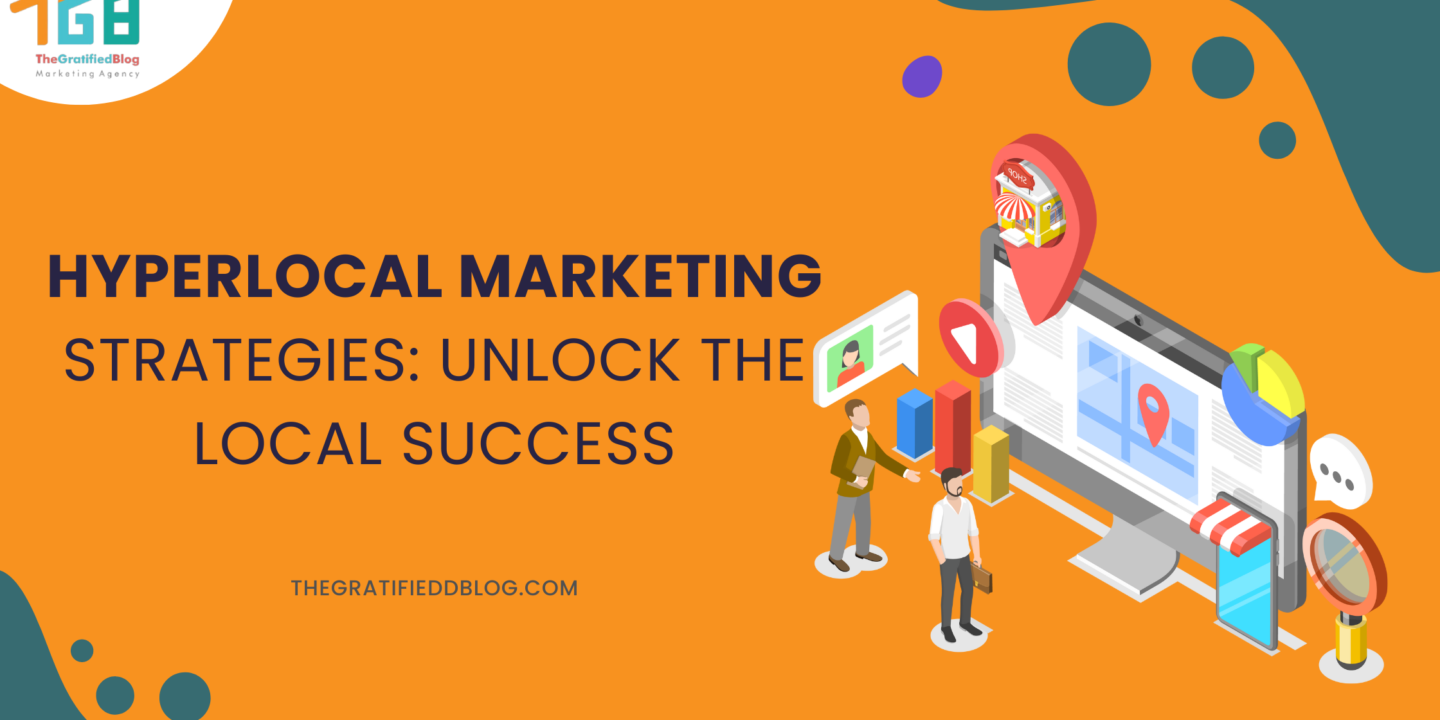
In today’s fast-paced digital era, where competition for consumer attention intensifies, businesses constantly explore creative methods to engage with their target audiences. Amidst this landscape, one strategy has emerged as a powerful tool for local companies seeking to carve out their niche in their communities: hyperlocal marketing.
Hyperlocal marketing, characterized by its focus on reaching highly targeted audiences in specific geographic locations, has become a cornerstone of modern marketing strategies.
This blog delves deep into hyperlocal marketing, exploring its definition, significance, and myriad strategies businesses can employ to amplify their presence and drive growth within their local markets.
Come along as we reveal the key elements to mastering hyperlocal marketing and unlocking your business’s full potential in your neighborhood.
Definition Of Hyperlocal Marketing
Hyperlocal marketing is a targeted marketing approach that reaches potential customers within a specific, localized area, such as a neighborhood, city district, or even a single street.
Unlike traditional marketing strategies that cast a wide net, hyperlocal marketing hones in on the immediate vicinity of a business’s physical location or the areas where its target audience resides. It leverages location-based targeting and personalized messaging to connect with consumers on a granular level, addressing their unique needs and preferences within their immediate surroundings.
Benefits Of Hyperlocal Marketing
Targeted Audience Reach:
Hyperlocal marketing allows businesses to pinpoint and engage with particular target audience segments based on geographic proximity. By leveraging location-based data and targeting techniques, businesses can tailor their marketing messages to connect with local consumers’ unique preferences, behaviors, and needs.
This targeted approach ensures that marketing efforts are directed towards individuals most likely to convert, Optimizing ROI while minimizing resource wastage.
Enhanced Customer Engagement:
One critical advantage of hyperlocal marketing is its ability to foster deeper connections and interactions with local customers. By delivering content, promotions, and experiences relevant to the local community, businesses can capture the attention and interest of consumers in their immediate vicinity.
This strategy focused on the local community and fostered a feeling of inclusion and affinity among customers, encouraging them to actively engage with the brand through social media, reviews, and word-of-mouth recommendations.
Increased Brand Loyalty:
Hyperlocal marketing initiatives demonstrate a commitment to understanding and addressing local consumers’ unique needs and preferences. By delivering personalized and localized experiences, businesses can cultivate emotionally solid connections with their audience, leading to greater brand loyalty and advocacy.
When customers feel valued and understood within their community, they are more likely to return to the business for future purchases and recommend it to others, thereby bolstering the brand’s reputation and longevity.
Competitive Advantage in Local Markets:
In today’s competitive landscape, standing out is essential for business success. Hyperlocal marketing provides businesses a powerful tool for differentiating themselves and gaining a competitive edge in their local markets.
By establishing a prominent presence within their immediate vicinity and engaging with local consumers personally, businesses can effectively position themselves as the preferred choice among local alternatives. This heightened visibility and relevance enable companies.
To draw in fresh clientele, retain current customers, and ultimately outperform competitors who may need a solid regional focus or personalized approach.
Having grasped the concept and advantages of hyperlocal marketing, it’s time to delve into its challenges and solutions.
Challenges And Solutions In Hyperlocal Marketing

Overcoming limited reach in hyperlocal campaigns:
One challenge in hyperlocal marketing is reaching a limited audience within specific geographic areas. To address this, businesses can employ strategies such as leveraging multiple channels (both digital and traditional), optimizing local SEO to improve online visibility, partnering with local influencers or businesses for cross-promotion, and utilizing geotargeted ads to more precisely target relevant audiences. By diversifying approaches and targeting tactics, businesses can effectively expand their reach within their hyperlocal market.
Managing data privacy and security concerns:
With the increased use of location-based technologies and data collection in hyperlocal marketing, businesses face data privacy and security challenges. To tackle this, companies must adhere to data protection regulations such as GDPR or CCPA, implement robust security measures for data storage and transmission, obtain explicit user consent for data collection, and be transparent about how their data will be used. Businesses can establish customer trust and reduce potential risks by prioritizing privacy and security.
Adapting to changing consumer behavior and trends:
Consumer behavior and trends in hyperlocal markets can evolve rapidly, challenging businesses to stay relevant. To adapt, companies can conduct regular market research and analysis to understand shifting preferences and behaviors, leverage customer feedback and insights to tailor offerings and messaging, stay agile and flexible in adjusting marketing strategies based on trends, and invest in Constant learning and innovation to remain at the forefront of industry trends. Businesses can thrive in hyperlocal marketing environments by staying proactive and responsive to changing consumer dynamics.
Having discussed the challenges and solutions in hyperlocal marketing, let’s focus on its strategies.
Strategies For Successful Hyperlocal Marketing

Utilizing Geotargeting and Geofencing
Understanding Geotargeting vs. Geofencing:
- Geotargeting: Geotargeting is a marketing tactic that delivers ads, messages, or content to users based on their geographic location. It leverages GPS data, IP addresses, or other location-based technologies to determine a user’s whereabouts. For example, if a user searches for “pizza near me” on their smartphone, geotargeting can display ads for local pizza restaurants.
- Geofencing: on the other hand, geofencing involves creating virtual boundaries or “fences” around specific geographical areas. These areas can be as broad as a city or as narrow as a single building. Users who enter or exit these predefined areas trigger targeted actions or notifications, such as receiving a discount offer when passing by a store.
- Difference: The critical difference between geotargeting and geofencing lies in their scope. Geotargeting targets users based on their current location, while geofencing targets users based on their proximity to predefined areas or boundaries.
Implementing Geotargeted Ads:
- Platforms: Businesses can implement geotargeted ads through platforms such as Google Ads, social media advertising (e.g., Facebook, Instagram), or location-based mobile apps.
- Targeting: Geotargeted ads allow businesses to target specific geographic locations where their target audience is. This precision targeting ensures that ads are shown to users more likely to be interested in the products or services offered.
- Benefits: By targeting users in specific geographic locations, businesses can enhance the relevance and efficiency of their ad efforts, leading to higher engagement, click-through rates, and conversion rates. For instance, a local coffee shop can target ads to users within a 5-mile radius, promoting its new seasonal drink specials to nearby customers.
Setting Up Geofencing Campaigns:
- Creation of Geofences: To set up a geofencing campaign, businesses define virtual boundaries around their physical locations or critical areas where their target audience frequents. That can include creating geofences around stores, event venues, or popular neighborhoods.
- Triggered Actions: When users enter or exit these geofenced areas, they trigger predefined actions or notifications. As an illustration, a retail store could transmit a push notification to users who enter the geofenced area, informing them of ongoing promotions or discounts.
- Benefits: Geofencing campaigns can drive foot traffic to physical locations by enticing users with targeted offers or reminders. They also help businesses engage with customers in real-time based on location, improving customer satisfaction and loyalty.
Engaging With Local Communities

- Participating in Local Events: Attending local events, festivals, or community gatherings is a proactive way to connect with residents and showcase your business. By engaging in such events, you can build relationships with potential customers, gain insights into local preferences, and effectively promote your products or services. Sponsoring or participating in these activities increases visibility and enhances your credibility within the community, leading to long-term customer loyalty and support.
- Sponsoring Local Organizations: Sponsoring or donating to local charities, sports teams, or community organizations is a meaningful way to demonstrate your business’s commitment to social responsibility. By aligning with causes or groups that resonate with your brand values, you can attract a broader audience of potential customers with similar interests or beliefs. This involvement boosts brand awareness and fosters goodwill and positive associations, ultimately contributing to a positive brand image and customer trust.
- Collaborating with Local Influencers: Partnering with influential individuals within your local community, such as bloggers, social media influencers, or community leaders, can significantly enhance your marketing efforts. Their endorsement or promotion of your business can reach a wider audience of residents who trust their opinions and recommendations. This collaboration amplifies your brand’s reach and builds credibility and trust among its followers, leading to increased local engagement, brand awareness, and potential sales.
Personalizing Marketing Efforts
- Customizing Offers Based on Location: By tailoring your marketing offers to meet customers’ specific needs and preferences in different geographic areas, you demonstrate a deep understanding of their local context. Implementing this personalized approach distinguishes you from competitors and builds a stronger connection with local customers, increasing their likelihood of choosing your business. Whether it’s offering seasonal discounts or promoting products popular in a particular region, customizing offers based on location boosts customer satisfaction and loyalty.
- Sending Hyperlocal Email Campaigns: Segmenting your email list based on location data allows you to craft hyperlocal email campaigns that resonate with recipients in each geographic area. By including localized content, promotions, or event announcements relevant to their region, you enhance the relevance and effectiveness of your email marketing. This targeted approach fosters a sense of belonging and engagement among local customers, driving higher email opens, clicks, and conversions for your campaigns.
- Utilizing Dynamic Content: Implementing dynamic content on your website and marketing materials enables real-time customization based on the user’s location or browsing behavior. This dynamic approach allows you to display different images, messaging, or promotions to users from other geographic areas, optimizing the user experience and increasing engagement. You create a more compelling and relevant marketing presence by delivering personalized content that resonates with local audiences, driving conversions and brand affinity.
Leveraging Social Media Platforms

- Using Location Tags and Check-Ins: Encouraging customers to tag your business location or check in when they visit social media platforms like Facebook, Instagram, or Twitter is a powerful way to boost your online visibility. This user-generated content exposes your business to their networks and serves as social proof within the local community. When potential customers see others engaging with your business, it enhances your credibility and encourages them to explore and support your brand.
- Engaging with Local Audiences on Social Media: Actively engaging with local audiences by responding to comments, messages, and reviews demonstrates your commitment to customer satisfaction. You build trust and stronger connections with local customers by showcasing genuine interactions and providing helpful information. This personalized approach fosters loyalty and encourages word-of-mouth referrals and positive recommendations within the community.
- Running Location-Based Ads on Social Platforms: Social media advertising platforms’ targeting features allow you to run location-based ads that target users within specific geographic areas. Whether promoting an upcoming event, offering a special discount, or sharing local testimonials, these ads can effectively resonate with your hyperlocal audience on social media. By tailoring your messaging and content to the local context, you increase the relevance and impact of your ads, driving engagement and conversions among your target audience.
By implementing these hyperlocal marketing strategies, businesses can maximize their visibility, engagement, and success within their local communities. Each tactic is crucial in connecting with nearby Attracting clients, fostering brand allegiance, and securing a competitive edge in regional markets.
Conclusion
Having gained an understanding of hyperlocal marketing, it’s evident that businesses can leverage targeted strategies to reach their local audience effectively. Companies can enhance brand visibility and customer engagement by employing the abovementioned tactics and driving growth within their market segments.
However, if you still have any questions related to the blog, please feel free to leave them in the comment section below. We will be happy to answer you.
Thanks for reading 🙂








No Comments